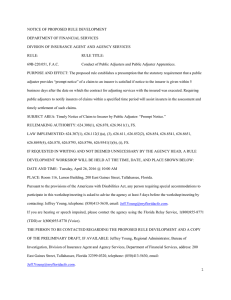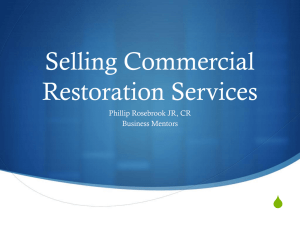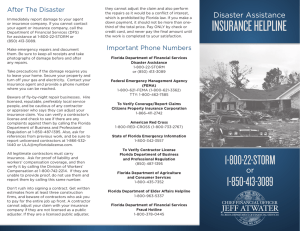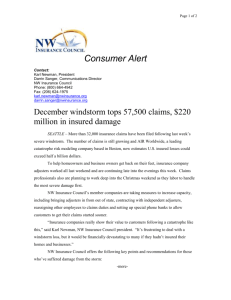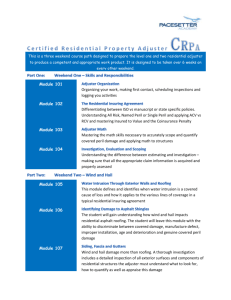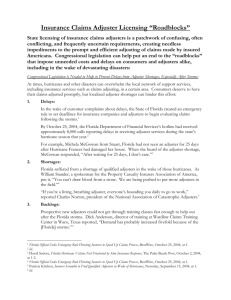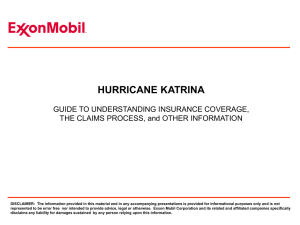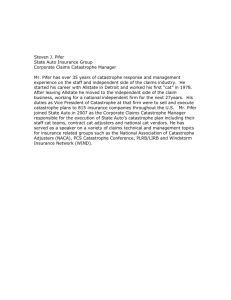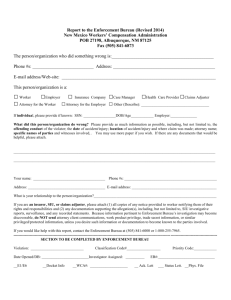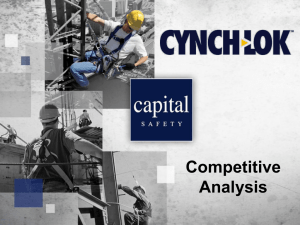naic emergency independent adjuster best practices & guidelines 8
advertisement
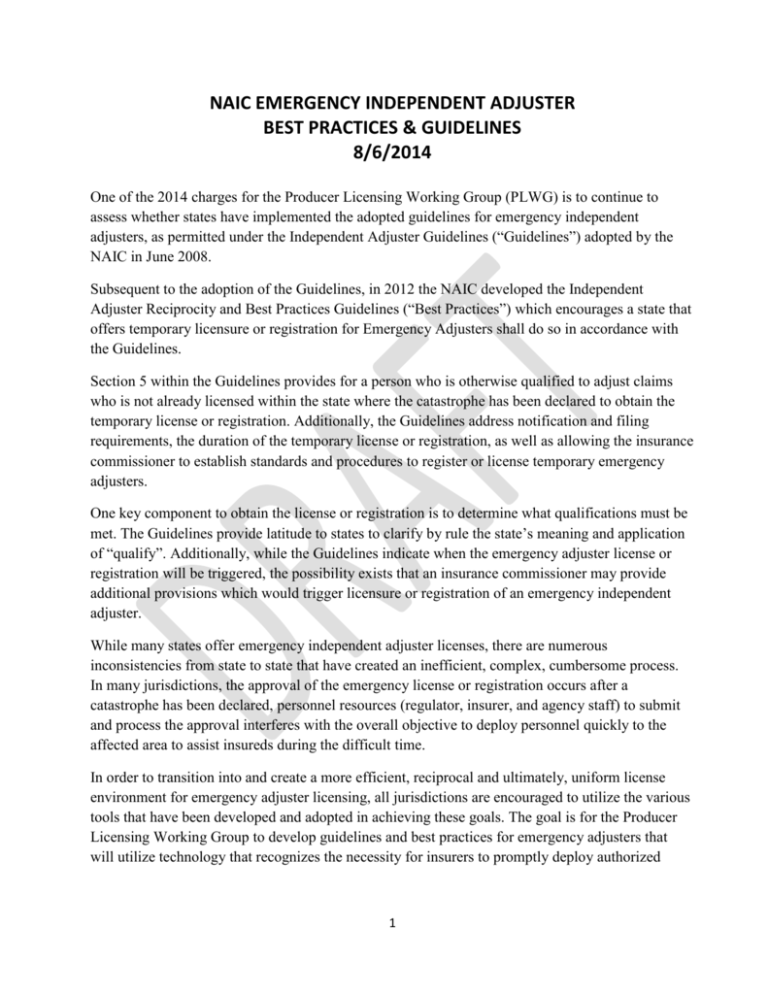
NAIC EMERGENCY INDEPENDENT ADJUSTER BEST PRACTICES & GUIDELINES 8/6/2014 One of the 2014 charges for the Producer Licensing Working Group (PLWG) is to continue to assess whether states have implemented the adopted guidelines for emergency independent adjusters, as permitted under the Independent Adjuster Guidelines (“Guidelines”) adopted by the NAIC in June 2008. Subsequent to the adoption of the Guidelines, in 2012 the NAIC developed the Independent Adjuster Reciprocity and Best Practices Guidelines (“Best Practices”) which encourages a state that offers temporary licensure or registration for Emergency Adjusters shall do so in accordance with the Guidelines. Section 5 within the Guidelines provides for a person who is otherwise qualified to adjust claims who is not already licensed within the state where the catastrophe has been declared to obtain the temporary license or registration. Additionally, the Guidelines address notification and filing requirements, the duration of the temporary license or registration, as well as allowing the insurance commissioner to establish standards and procedures to register or license temporary emergency adjusters. One key component to obtain the license or registration is to determine what qualifications must be met. The Guidelines provide latitude to states to clarify by rule the state’s meaning and application of “qualify”. Additionally, while the Guidelines indicate when the emergency adjuster license or registration will be triggered, the possibility exists that an insurance commissioner may provide additional provisions which would trigger licensure or registration of an emergency independent adjuster. While many states offer emergency independent adjuster licenses, there are numerous inconsistencies from state to state that have created an inefficient, complex, cumbersome process. In many jurisdictions, the approval of the emergency license or registration occurs after a catastrophe has been declared, personnel resources (regulator, insurer, and agency staff) to submit and process the approval interferes with the overall objective to deploy personnel quickly to the affected area to assist insureds during the difficult time. In order to transition into and create a more efficient, reciprocal and ultimately, uniform license environment for emergency adjuster licensing, all jurisdictions are encouraged to utilize the various tools that have been developed and adopted in achieving these goals. The goal is for the Producer Licensing Working Group to develop guidelines and best practices for emergency adjusters that will utilize technology that recognizes the necessity for insurers to promptly deploy authorized 1 adjusters to respond to claims by creating a simplified, streamlined process to effectively and efficiently approve catastrophic/emergency adjusters when a catastrophe is declared. To transition into and create a more reciprocal and ultimately, uniform process to license or register emergency adjusters, all jurisdictions are encouraged to utilize the various tools that have been developed and adopted in achieving these goals. RECOMMENDED GUIDELINES AND BEST PRACTICES FOR REGULATORS 1. Adopt Section 5 and other provisions in the Independent Adjuster Guidelines to ensure consistency with standards and requirements. 2. License/Registration Qualification – requiring the individual to be licensed in their home state or a designated home that has testing, fingerprinting and continuing education requirements. 3. Create an electronic filing process for emergency/catastrophic adjusters.(A state may consider utilizing NIPR by updating state business rules to allow for these types/classes of licenses or registrations or by contract with a third party vendor. 4. Submit Emergency Adjuster information to the NAIC Producer Database (PDB). This may occur by reviewing and updating your state specific business rules on file with the National Insurance Producer Registry (NIPR). 5. Ensure that the automated notification process is off site and preferably out of state so if the emergency occurs locally, adequate resources are available to respond and issue approval to the adjusters. 6. Develop NAIC Uniform Emergency Adjuster applications/registrations consistent with the adopted Guidelines. Until such time the application is developed, use the NAIC Uniform Adjuster Application for individuals and business entities. 7. Work with state officials responsible for oversight of emergency situations to coordinate its activities to determine if any other credentials (such as photo ID or badge) are required. 8. If fingerprinting is not required in your state, inquire of the company represented whether a background check was performed or an alternative method for meaningful background check occurred. 9. Individuals wishing to access an emergency area must determine who the “incident commander” is in order to request and obtain permission to enter the scene. This person will determine who can access an area for purposes of adjusting no matter what part of the country you are in, including federal or tribal lands and across state borders or countries (i.e. Canada). The incident commander is responsible for the safety of all concerned and for the integrity of the scene so is the ultimate authority for access to an emergency area. 2 10. Coordinate with other states or jurisdictions when the catastrophe involves multiple states/jurisdictions. 11. Establish a one-time fee (if applicable) for a specified time period and not per disaster. DISCUSSION ITEMS 1. Creation of a national repository/database (NIPR/NAIC to create a central repository for emergency adjuster registration. States would have an option to use or not, but it would NOT be customized per state. ) a. National ID card (license w/photo/disaster ID # – is this feasible when most licenses are now available for printing online?) b. Create a prior approval process so when an emergency is triggered, the emergency adjuster has been pre-approved by as state(s), the approval is posted online, and the adjuster is ready for deployment c. Create a separate number system posted to the Emergency Adjuster Database (EAD) d. Post emergency states needing adjusters, listing the type of disaster and what companies or federal agencies to contact in order to provide assistance with the disaster e. Post companies looking for adjusters-what types, etc. or just let carriers use the site for their hiring. f. It would be nice to have a mechanism to show which companies they are currently working through or have an "available" flag/symbol to indicate they are available for hire or mobilization to a disaster g. Is it possible to post the individual’s permissions or certifications (such as CAPP ) for federal (national parks or forests) or tribal access permissions h. Do we want to post requirements based on where the catastrophe is? (see permissions below) or is this the companies responsibility? i. Do we want to allow adjusters to indicate that they are available for hire (have an "available" flag/symbol) 2. Process to obtain other permission, certifications or approval a. What is the process to obtain approval or permission on tribal lands (Based on the notion of sovereign nations for each tribal nation, can adjusters be qualified to enter these areas to assist and is each a special permission (likely) based on that tribe's criteria? How does one qualify for that or is it possible) Would an FBI check be required to access federal and/or tribal lands b. What is the process to obtain approval under federal lands (national parks or forests) 3. What process could be developed that would facilitate approval in multiple states when a disaster crosses borders into other states? 4. What if the land is part private (covered under private policy) and part federal (covered under federal policy)? 3
